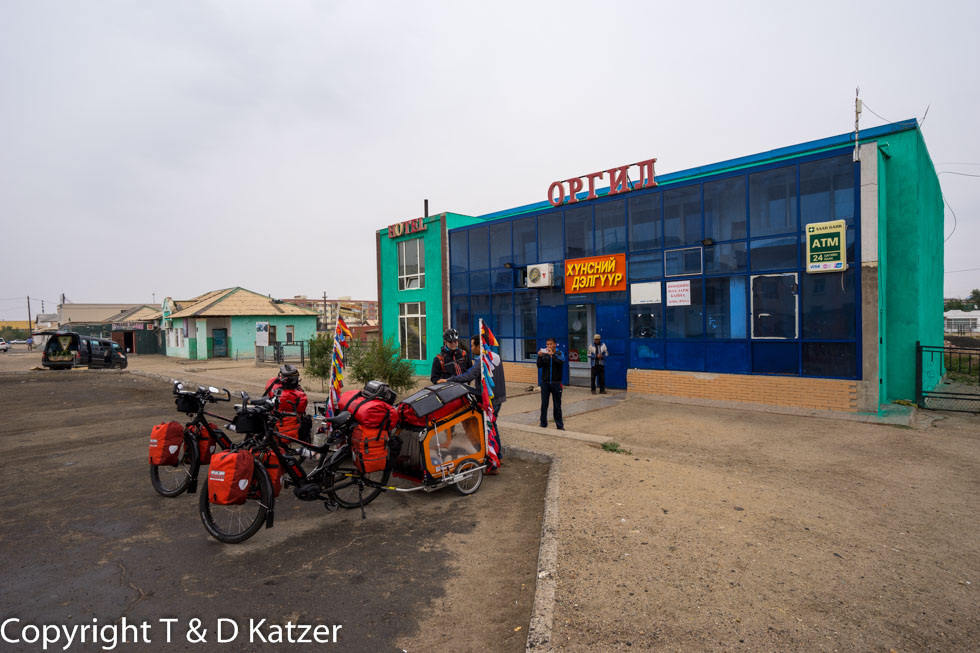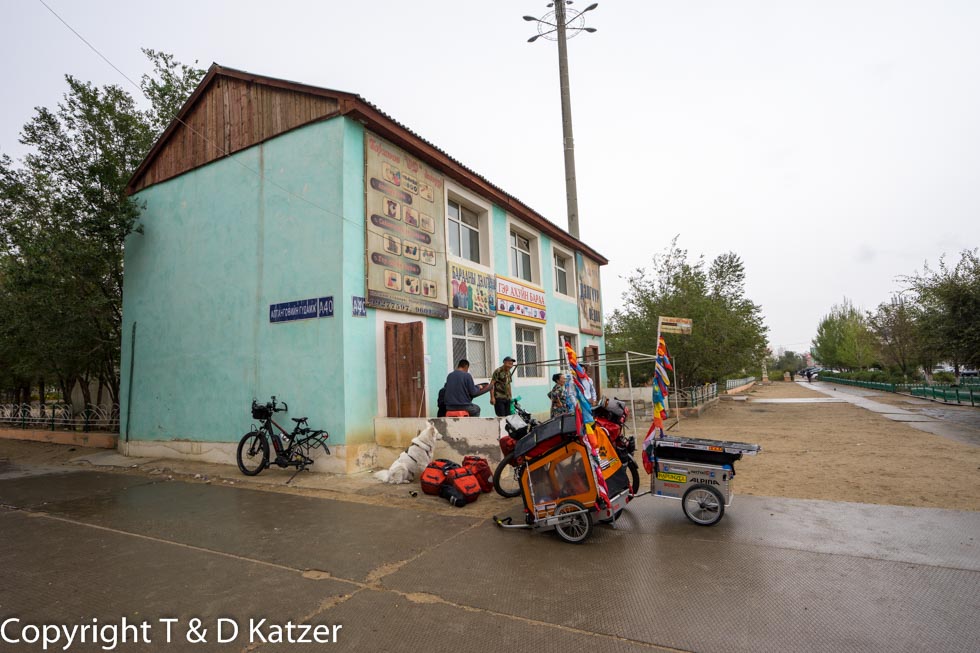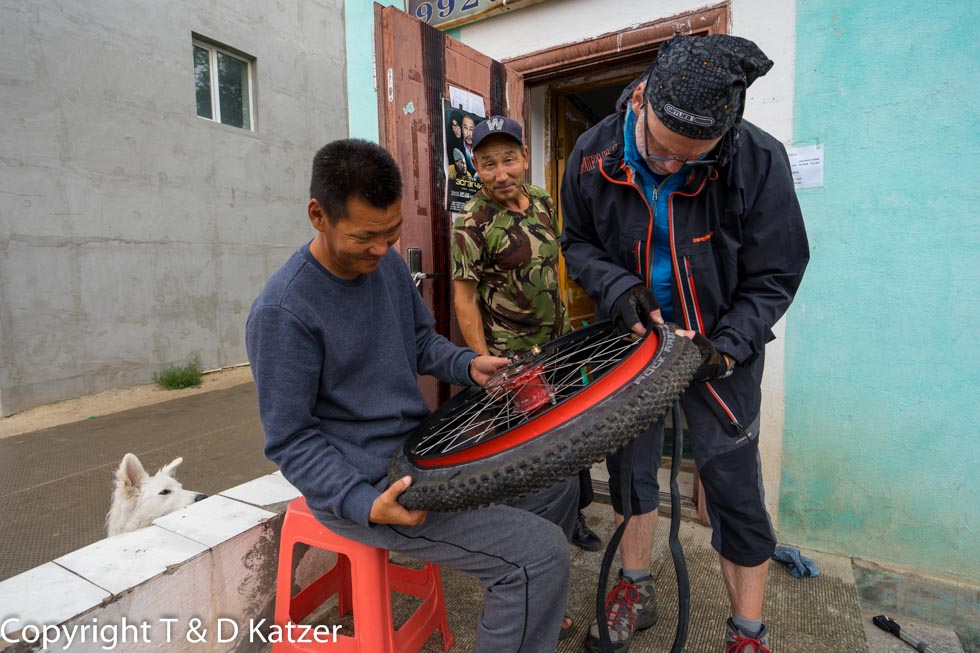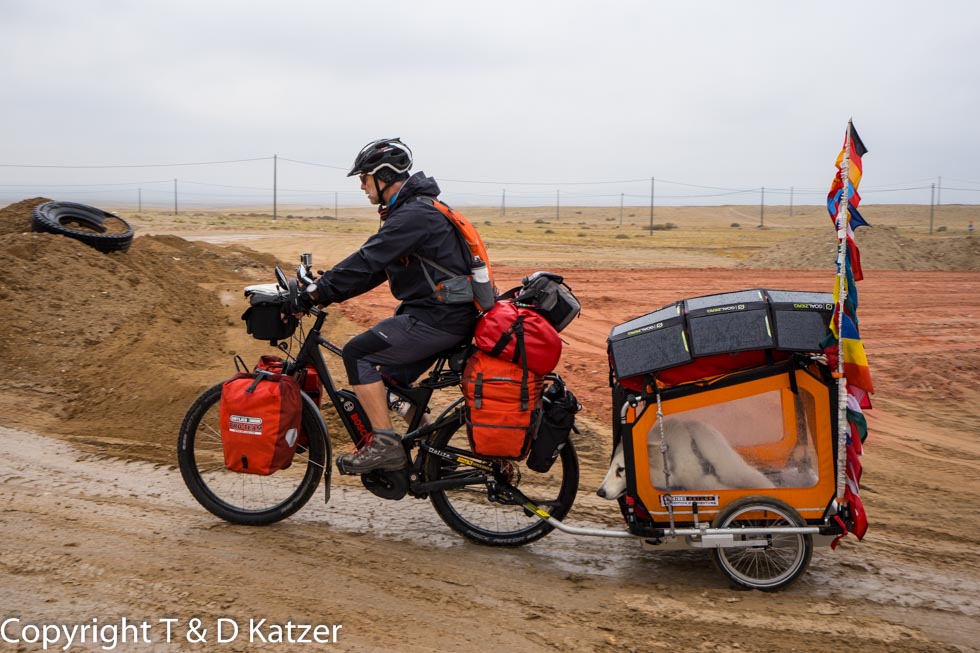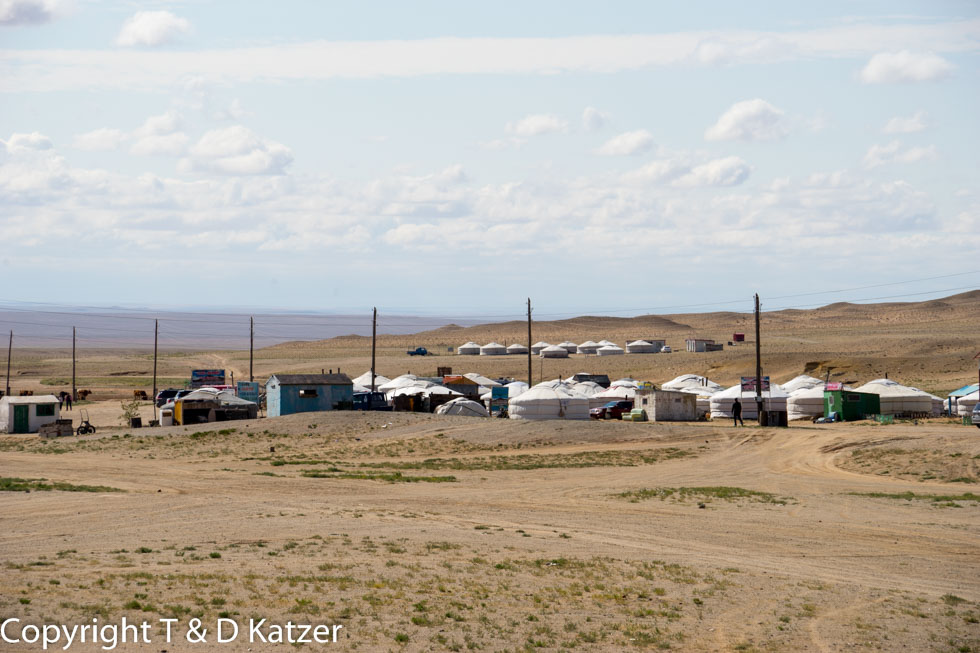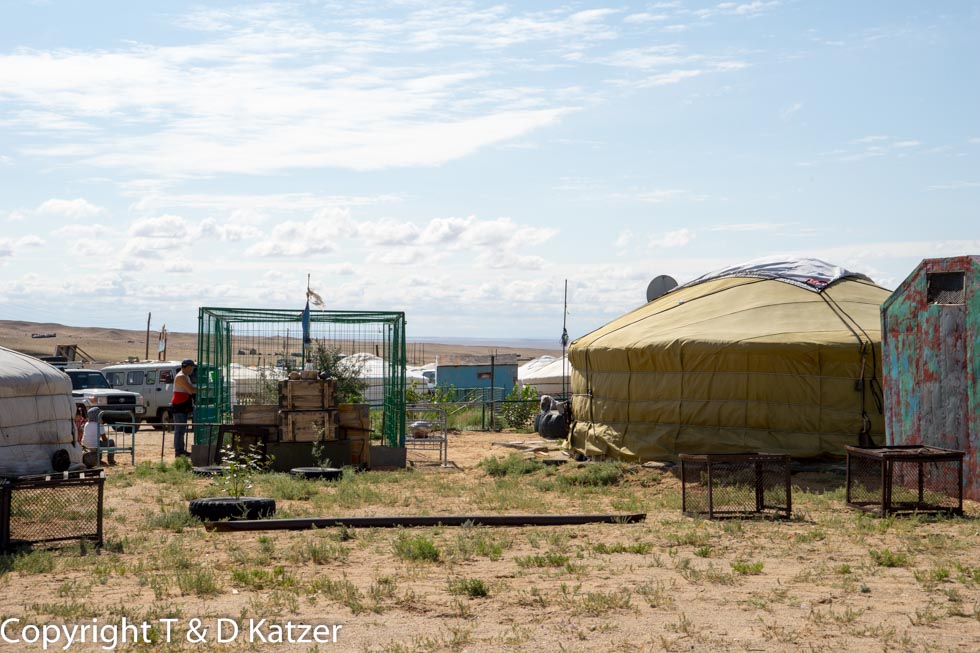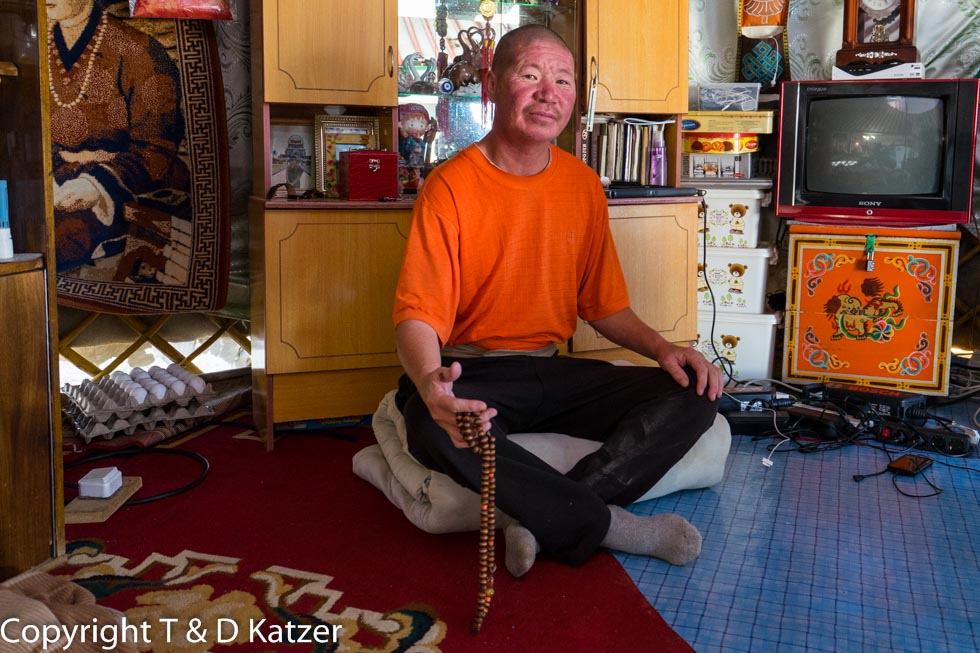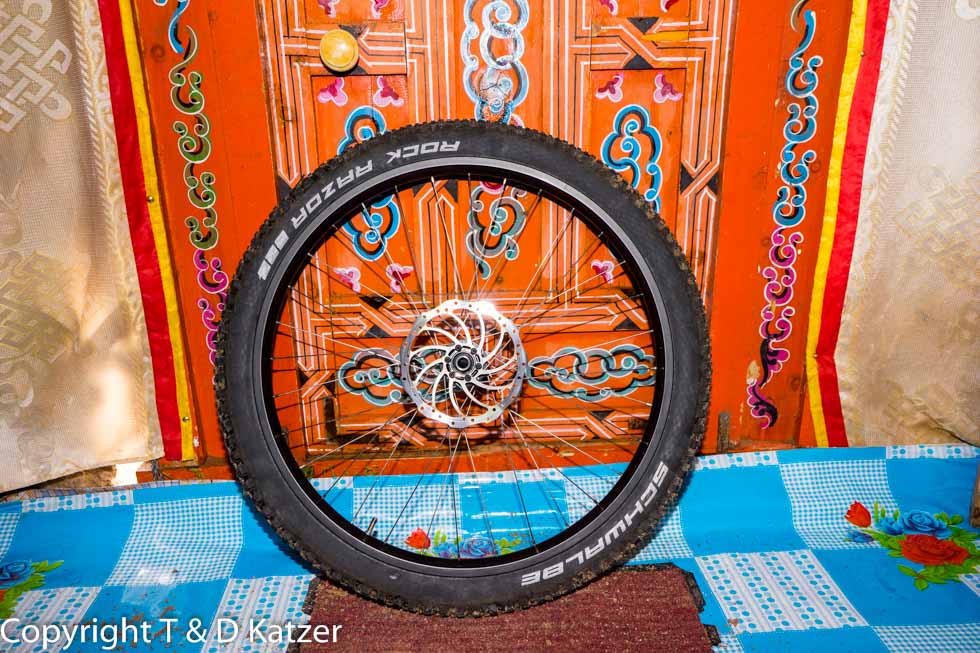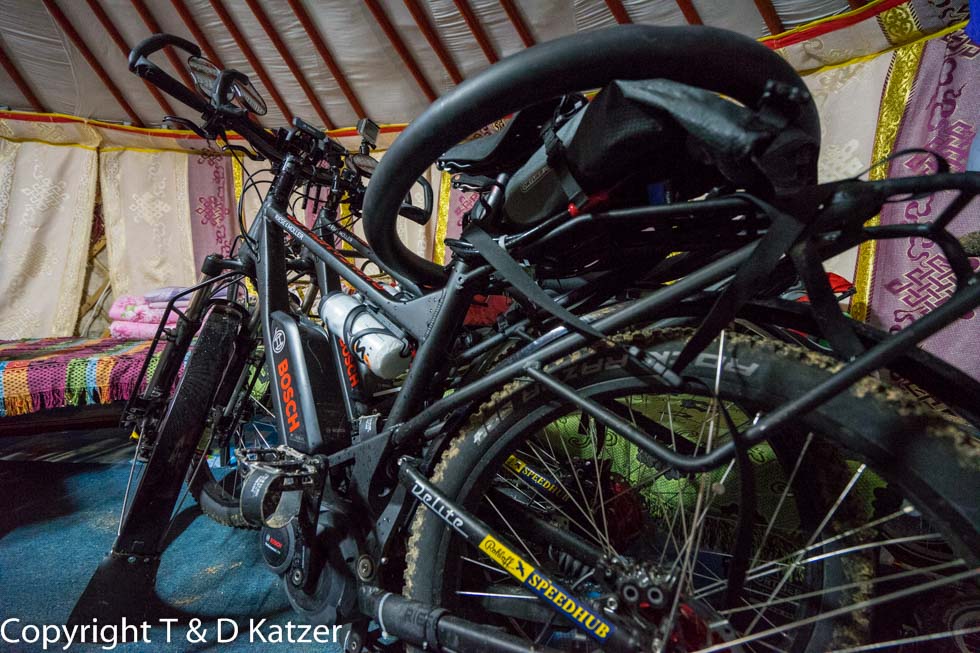
Inferno of wetness and like in a Mad Max movie
N 44°35'42.1'' E 110°16'19.6''
Date:
04.09.2015
Day: 68
Country:
Mongolia
Location:
Khamariin Khiid
Latitude N:
44°35’42.1”
Longitude E:
110°16’19.6”
Daily kilometers:
54 km
Total kilometers:
9,095 km
As the crow flies:
37 km
Aver. Speed:
22 km/h
Maximum speed:
35 km/h
Travel time:
2:26 hrs.
Soil condition:
Asphalt very good
Maximum height:
1.000 m
Total altitude meters:
3.870 m
Altitude meters for the day:
173 m
Sunrise:
07:03 am
Sunset:
8:13 pm
Temperature day max:
20 °C
Departure:
11:20
Arrival time:
15:30
Total plate tires:
3
Plate front tire:
1
Flat rear tire:
1
Plate trailer tire:
1
(Photos of the diary entry can be found at the end of the text).
The woman who is responsible for welcoming guests and keeping the rooms clean helps Tanja carry the saddlebags down. While I’m loading the bikes, Roman comes by, having parked his minibus full of melons next to the hotel. He wants to give us another watermelon as a parting gift. “Thank you Roman, but we don’t have room to load them,” we decline. “Well, you’ll get one when you get back from Khamariin Khiid,” the likeable young man replies with a laugh.
It is raining lightly. A dense cloud cover has settled over Sainshand, making the small town that was still sweating in the hot desert sun yesterday suddenly appear bleak and gray. The temperature has dropped to 15 °C. Certainly not a good day for cycling, but today we want to reach the Buddhist monastery of Khamariin Khiid, next to which there is also supposed to be a large energy center. For the first time, the roads are slippery from the rain. It feels like I’ve pulled a film of grease over the asphalt. “We have to be damn careful not to fall!” I shout to Tanja. The road looks terrible. Puddles, cracks, crevices and earth faults force us to zigzag our way along. Again and again I turn around and try to take a look at my rear tire. The poor grip of the tire really scares me. “When we get into winter, it’s going to be a real slippery ride with the tires,” I say, moving carefully through the traffic. As we bump over a hill, we reach the center of the city after about three kilometers. Here you can see where the 25,000 inhabitants live. A whole range of hotels offer rooms in different categories. If we had known this when we arrived and still had some energy left in our batteries, we would certainly have been better accommodated here. A cab driver honks at me. I almost twisted my handlebars in shock. He points frantically at my rear tire. I wonder what he wants from me? Maybe there is something wrong with my rear tires and I just imagined the slipperiness? I decide to stop, put the bike on the stand and can’t believe it. A flat tire. “I’ve got a flat tire!” I shout to Tanja. “Oh no.” “Oh yes,” I reply. Together we push my bike over the steep kerb and park it next to a store. It’s still drizzling, which doesn’t exactly lift my spirits. A group of schoolchildren comes by. The two Europeans are a fantastic change for them. They talk excitedly, talk shop about the bikes and touch everything to check if it’s real. Meanwhile, we unload my bike completely and put the saddlebags in a pile next to the store. Removing the rear tire is a bit tricky because of the disc brake and the tubeless hub. To get it out better, I unscrew the derailleur hanger, and so that the chain doesn’t lie in the dirt, I attach it to the frame of the Delite with a cable tie. Because I help out at Riese und Müller before every bike trip and am trained to assemble the expedition bikes, I am able to carry out most of the smaller repairs myself. The time invested in the workshops is worth its weight in gold and has already saved me a lot of headaches over the last 20,000 kilometers on my bike.
“Why does a flat always have to be in the rear tire?” I get annoyed. The store owner and two of his friends immediately give me a hand. Before I insert a new hose, we check the jacket for foreign objects. There is nothing to be found. I take a new inner tube, pull it in and with the help of my fellow riders the bike is quickly reassembled. “Ih bajrlalaa”, (thank you very much) I say thank you, then an hour later, we continue our journey. “Always straight ahead,” a man points us in the right direction. As we leave the town behind us, we slide down a slippery and muddy clay track. Road closure signs warn against driving on. “You’ve come to the wrong place. If you want to go to Khamariin Khiid, you have to go back into town and turn right at the traffic circle,” explains a friendly road worker. After a ten kilometer detour, we pass the toll station where drivers have to pay for the brand new asphalt road. As it starts to pour more and more, we slip into our rain gear. As soon as the ticket booth disappears in the rear-view mirror, the heavens open their floodgates. At first it’s restrained, but from minute to minute it hammers more and more from the sky. After 20 minutes, the professional rainwear gives up and the unpleasant wetness makes its way through our underwear. In the meantime, the fun is over – if it ever was. The desert is drowning in the worst rainfall we have seen since 2005. We have never experienced such a downpour on the entire route from Germany to Mongolia. Rushing torrents carve their way through the flat land and carve deep gorges into the sand. To the left and right of the asphalt strip, the Gobi sinks into an inferno of wetness. Just don’t get a flat tire now, I pray. Because cyclists seem to be tormented by headwinds most of the time, the drops whip us in the face even at this hour. It feels like a thousand needles are pricking us. When the first abdominal cramp comes on, I am downright terrified. “No, please don’t. No stomach cramps. Just no stomach cramps,” I say to myself as the next attack hits me. This is actually the wrong moment.
The man-made tar strip stretches over a few elevations. When it goes upwards, the water flows towards us. So we climb a wide, shallow river. I would like to photograph the natural phenomenon but this action would destroy the camera. Meanwhile, I try to capture the scene with the small, waterproof GoPro camera attached to the handlebars. However, during the later evaluation it turns out that the aggressive rain completely floods the camera’s optics, so that you can hardly recognize anything. In the meantime, we swallow the water. It rushes from the helmet over the face into the mouth. Then it flows into the collar, no matter how high I have pulled it. In Tanja’s case, the torrent even runs out of her shoes again. The sky seems to want to swallow us up, even devour us. The black towers of clouds interlock like battling demons and look down on us grimly. Suddenly I am attacked by another stomach cramp. “Stop!” I shout against the rain to give Tanja, who is ducking in my slipstream, enough time to slow down her road train. Only then do I pull my brakes and put the bike on the stand. As luck would have it, we stopped over a concrete pipe that carries the desert water under the road. I jump into the tube, which fortunately has little water at the moment. A little later, we continue our wet journey. After an hour, the nasty clouds move on and only sprinkle us with their drizzle. At a height, huge camels gaze boredly at us. The continuous cloudburst didn’t seem to bother them much.
After 2 ½ hours and 54 km, we reach the monastery. There are no people or tourists to be seen. It’s probably because of the terrible weather. Countless yurts have been erected next to the monastery. The first rays of sunlight illuminate the felt mushrooms that invite you to spend the night. In front of some of them is a sign advertising the hotel. “So this is the local hotel complex,” I joke. We let our e-bikes roll through the mud and stop in front of one of the camps. “Come on! Come on!” shouts one of the yurt owners, while a few others wave to us to spend the night with them. The competition is apparently merciless at this time of year. “Is there electricity?” I ask, because we look really old without being able to charge our batteries here. “But yes. Here you see?” says the yurt owner, pointing to a socket lying in the open on the wet ground. “Wow, that’s dangerous,” I realize. “Yes, it’s dangerous,” he answers quite dryly despite the wetness. Because it’s dirty in the yurt, I go to a few other places. The owner of the neighboring camp speaks very good English. “My yurts are the cleanest. Look,” says the man, who introduces himself as Boris, and leads me into one of the Mongolian tents. In fact, it is licked clean in there. “Do they have electricity?” I ask. “You can charge your devices in my kitchen yurt. That’s no problem. And if you need hot water, I’ll bring you as much as you want,” he offers, and we stay with him for the night. He helpfully carries the equipment into the felt tent. Because the entrance is too small and Boris advises us not to leave anything outside, I dismantle our trailers. Then we also carry these inside. “Where did you learn English so well?” I ask our host. “I lived in India for five years.” “In India? What did you do in India?” “I went to university there and studied Buddhism,” he explains. “And now you live here in the desert and rent out yurts to tourists?” “Yes, we live here all year round. Hardly anyone comes to Khamariin Khiid in winter, but I like it here. This is my home,” he explains with a sweeping gesture across the desert. “Must be quite cold in winter?” I ask. “It works. Only minus 25 °C to minus 30 °C, but the wind is sometimes extreme,” he says and laughs.
Meanwhile, the clouds have decided to let the Gobi sink into the water again. Boris’ father comes to visit us to check the tent for leaks. As custom and hospitality would have it, we offer him a hot tea and a few cookies that we have brought with us. During our conversation, like many Mongolians, he touches the tires of our bikes to check the pressure. As he pushes Tanja’s front tire, he laughs. “He’s totally flat,” I snort out my tea. “Oh no, now I wanted to get some rest and I have to fix another flat tire. What on earth have we got ourselves into?” I ask myself and immediately get to work. Once again, I can’t make out what has penetrated the coat. Despite close examination, no foreign body can be detected.
As darkness falls over the yurt camp and the desert outside, we eat the bread, cucumbers and sliceable cheese we have brought with us, which, according to the manufacturer, keeps for almost a year. It’s fascinating how quickly you become modest and enjoy simple food. “You have to see this,” says Tanja as she steps back into our damp den after a walk with Ajaci. “What is it?” “It looks really surreal out there. Really bizarre. Simple wooden sheds are erected between the felt tents. Then there are broken, rusty motorcycles and cars standing around. One even has a small fenced-in garden with, imagine this, plastic flowers. Well…, it reminds me more of a Mad Max movie than a yurt camp in the Gobi desert. Many of the yurt camp owners decorate their tents with neon signs. There are very simple, tiny grocery stores. Young people play basketball in the temporary light. You’d think it was about the World Cup. There are lots of dogs running around in between. Some are really aggressive. They stormed towards us and wanted to bite Ajaci. Somehow the whole scene is creepy.
It is about 23:00. We are lying on the clean, hard mattresses and have just dozed off when someone tries to open the yurt door. “Do you hear that?” whispers Tanja. “Yes.” “There’s someone there.” “Yes,” I reply and listen. The door rattles again. This time stronger than before. Fortunately, I locked the simple, painted door with the sliding lock before going to sleep. When the intruder now pulls the handle with brute force, it is too much for Ajaci. “Wow! Wow! Wow!” he barks, whereupon the shaking at the door stops immediately. Ajaci now growls menacingly. Then we hear the sound of footsteps shuffling in the desert sand. “Good boy. You’re a great watchdog,” we praise our dog and try to find sleep again…
The live coverage is supported by the companies Gesat GmbH: www.gesat.com and roda computer GmbH www.roda-computer.com The satellite telephone Explorer 300 from Gesat and the rugged notebook Pegasus RP9 from Roda are the pillars of the transmission.
